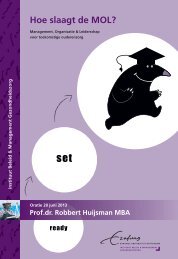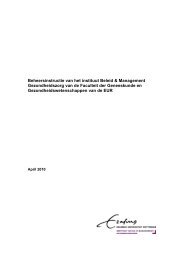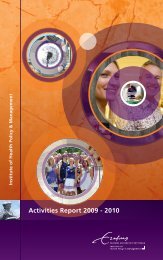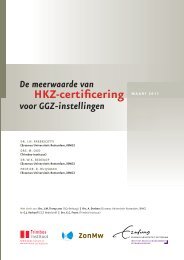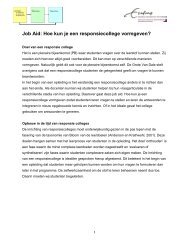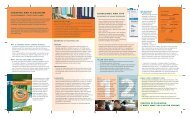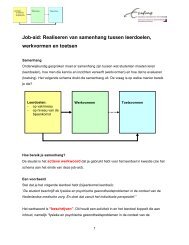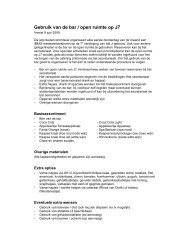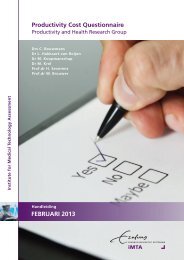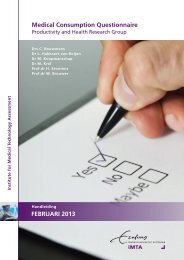44Chapter 3Total costs of treatment for CDH amount to € 42,658 (€ 47,495 withoutdiscounting). The discounted costs comprise direct medical costs (78%), directnonmedical costs (1%), indirect medical costs (20%), and indirect nonmedicalcosts (2%).EffectsLife expectancy. Of the 261 traced patients, 86 (33%) patients had died with amean life span of 1.5 years (median, 3 days). We assumed that the survivors willhave a normal life expectancy of 75.4 years. Accordingly, the mean lifeexpectancy of all patients, including the deceased, amounts to 51.1 years.Health state description. The prevalence of symptoms in CDH patients will bepresented extensively in Chapter 4. To summarize, the disease-specific symptomsare not unique to CDH patients but almost all symptoms are more frequentlyreported in CDH patients than in the general population. Statistically significantdifferences were found between CDH patients and the controls concerningcoughing up sputum when waking up, shortness of breath when performingheavy physical activities, experiencing constraints as a result of respiratoryproblems, suffering from hiccupping (because of its intensity or duration),heartburn, and stomach aches. This results in a significantly higher symptomscore for CDH patients under the age of 19 (n = 81; mean age, 10.3; meansymptom score, 6.8) than for their contemporaries in the control group (n = 53;mean age, 7.4; mean symptom score, 4.9).It appears from the medical consumption questionnaire that, compared with thegeneral population, a significantly larger proportion of the CDH patients under theage of 20 was admitted to a hospital (17% v 4%) and consulted a physiotherapist(13% v 7%) during the last 12 months. A significantly larger proportion of theolder CDH patients (between 20 and 45 years of age) than the general populationconsulted a general practitioner during the last 12 months (96% v 74%) and usedprescribed medication during the last 14 days (41% v 10%).Health state valuation. Patients from 5 to 15 years scored 0.92, and adultsscored 0.91 on the EQ-5D index. Both values do not significantly differ from thereference scores for the general population (0.93 both in adults 18 and inchildren 19 ). The mean quality of life of all patients is 0.91. Given the lifeexpectancy of 51.1 years, treating CDH produces 46.5 (51.1 x 0.91) QALYs. Assaid before, we assumed that 'no treatment' would bring about death shortly afterbirth. In this case, the number of QALYs equals zero. Treatment for CDHcompared with 'no treatment' thus results in a gain of 46.5 QALYs. Whendiscounted at 5% per year, the QALY gain is 17.5.Cost-effectivenessCosts per QALY of treatment for CDH compared with 'no treatment' amount to€ 2,434 (€ 1,022 without discounting).
Cost-Effectiveness of Treatment for Congenital Diaphragmatic Hernia 453.4 DISCUSSIONThe cost-effectiveness ratio amounts to € 2,434 (costs per QALY), which indicatesgood cost-effectiveness. We conclude that, although CDH patients might fall intothe costliest category of all hospitalized patients, the effects of treatment areworth the costs. Only minor social and demographic differences were foundbetween CDH survivors and the general population. The costs of treatment aresubstantial (€ 42,658), mainly consisting of costs of the initial hospitalization. Tothe best of our knowledge, complete direct medical costs of treatment for CDH(i.e., not only those of ECMO), including all presenting patients, have not beencalculated previously. For example, some studies did not include the full range ofcosts, 20,21 because the research questions made it unnecessary to include, forexample, costs of surgeries and hospital overhead costs. The methods of the fewother studies reported in the literature are either not sufficiently refined forcalculating real economic costs 22,23 or unclear. 24 With the exception of theresearch of Waitzman et al., 22 no attempts have been made to consider other costcategories that should also be taken into account from a societal perspective. Upto adulthood, CDH patients to some degree, suffer from disease-specificsymptoms such as pulmonary problems and stomach aches. Previous studieshave suggested that this is the case. 8-11,25 Taking medical consumption as anindication of quality of life, the quality of life of CDH patients seems lower thanthat of the general population. Despite these findings, the EQ-5D shows that theoverall quality of life of CDH patients does not differ from the general population.This outcome is in line with our introductory remark that, in general, CDHsurvivors can expect good survival.Direct medical costs could be calculated only for 38 patients born in a rather shortperiod (between 1993 and 1996). No conclusions are drawn on patients born inother periods. Our results are likely to be representative for most patients born inthat era. Of course, we cannot be sure that the same results apply to previous orfuture patients. For example, treatment patterns may change in the future.However, some parts of the calculations, such as the large share of the costs ofhospital days in the total direct medical costs, are likely to show similar results.Many of the reflections on the cost calculations in our study in ARM patients 4 alsoapply to the current study. For example, we chose solutions that were more likelyto overestimate the costs of treatment. We therefore consider it unlikely that wehave presented a too favorable picture of cost-effectiveness. One particularcaveat should be made, however, on the cost calculations in this study, i.e., thecosts of ECMO were taken from a large Dutch survey on ECMO in neonates. 14 It isunlikely, however, that this would lead to substantial bias, because both ourstudy and the ECMO survey were performed in patients at the Sophia Children'sHospital, and in both studies the cost calculations were largely based on the samefinancial accounts. Moreover, only 21% of the patients in this study underwentECMO treatment, and the costs of ECMO comprised only 6% of all direct medicalcosts.
- Page 3:
COST-EFFECTIVENESS OF NEONATAL SURG
- Page 6 and 7: DOCTORAL COMMITTEEPromotors:Prof.dr
- Page 9 and 10: PUBLICATIONSChapters 2 to 7 are bas
- Page 11: 6ChapterINFORMAL CARE FOR CHILDREN
- Page 14 and 15: 2Chapter 11.1 BACKGROUND AND MOTIVA
- Page 16 and 17: 4Chapter 1provides a good overview
- Page 18 and 19: 6Chapter 1disability, and death of
- Page 21: Introduction 9particular equity pri
- Page 25 and 26: Introduction 1320. Oostenbrink JB,
- Page 27 and 28: Introduction 1554. Heyman MB, Harma
- Page 29 and 30: THE COST-EFFECTIVENESS OFTREATMENT
- Page 31: Cost-Effectiveness of Treatment for
- Page 35 and 36: Cost-Effectiveness of Treatment for
- Page 37 and 38: Cost-Effectiveness of Treatment for
- Page 39 and 40: Cost-Effectiveness of Treatment for
- Page 41 and 42: Cost-Effectiveness of Treatment for
- Page 43 and 44: Cost-Effectiveness of Treatment for
- Page 45: Cost-Effectiveness of Treatment for
- Page 48 and 49: 36Chapter 3ABSTRACTBackground/Purpo
- Page 50 and 51: 38Chapter 33.2 MATERIALS AND METHOD
- Page 52 and 53: 40Chapter 3child's date of birth) a
- Page 54 and 55: 42Chapter 3diaphragm was closed (Ta
- Page 58 and 59: 46Chapter 3Regarding the treatment
- Page 60 and 61: 48Chapter 3REFERENCES1. Stolk EA, P
- Page 62 and 63: 50Chapter 332. Jaillard S, Pierrat
- Page 64 and 65: 52Chapter 4ABSTRACTAims:To examine
- Page 66 and 67: 54Chapter 4Outcome measuresThe pati
- Page 68 and 69: 56Chapter 4Clearly, the symptoms st
- Page 70 and 71: 58Chapter 4The respondents did not
- Page 72 and 73: 60Chapter 4Table 4.4TAIQOL Scores o
- Page 74 and 75: 62Chapter 44.4 DISCUSSIONIn this pa
- Page 76 and 77: 64Chapter 4ACKNOWLEDGMENTSWe are in
- Page 78 and 79: 66Chapter 418. Coons SJ, Rao S, Kei
- Page 80 and 81: 68Chapter 5ABSTRACTObjective:Extrac
- Page 82 and 83: 70Chapter 5treatment. 26,27 Finally
- Page 84 and 85: 72Chapter 5CostsOnly direct costs w
- Page 86 and 87: 74Chapter 5summarized in Table 5.2.
- Page 88 and 89: 76Chapter 5Table 5.3 Direct Medical
- Page 90 and 91: 78Chapter 5Figure 5.3 illustrates o
- Page 92 and 93: 80Chapter 5severely ill newborns—
- Page 94 and 95: 82Chapter 5REFERENCES1. Bartlett RH
- Page 96 and 97: 84Chapter 533. Meinert CL: Extracor
- Page 98 and 99: 86Chapter 568. Hui TT, Danielson PD
- Page 100 and 101: 88Chapter 6ABSTRACTObjective:To inv
- Page 102 and 103: 90Chapter 6a rule. The health-relat
- Page 104 and 105: 92Chapter 6Regression analysis of h
- Page 106 and 107:
94Chapter 6that caregiving for thei
- Page 108 and 109:
96Chapter 6Table 6.5 CareQol Compar
- Page 110 and 111:
98Chapter 6children with a disabili
- Page 112 and 113:
100Chapter 6This study was of impor
- Page 114 and 115:
102Chapter 618. Poley MJ, Stolk EA,
- Page 116 and 117:
104Chapter 654. Boman KK, Viksten J
- Page 118 and 119:
106Chapter 7ABSTRACTMortality rates
- Page 120 and 121:
108Chapter 77.2 THE RELEVANCE OF CO
- Page 122 and 123:
110Chapter 7In the early 2000s, our
- Page 124 and 125:
112Chapter 7Table 7.1 Economic Eval
- Page 126 and 127:
114Chapter 7More from a policy pers
- Page 128 and 129:
116Chapter 7also expect that life-s
- Page 130 and 131:
118Chapter 7entirely justified, for
- Page 132 and 133:
120Chapter 723. Sydorak RM, Nijagal
- Page 134 and 135:
122Chapter 765. Glaser AW, Davies K
- Page 137 and 138:
GENERAL DISCUSSION:A GUIDED TOURPRO
- Page 139 and 140:
General Discussion: A Guided Tour P
- Page 141 and 142:
General Discussion: A Guided Tour P
- Page 143 and 144:
General Discussion: A Guided Tour P
- Page 145 and 146:
General Discussion: A Guided Tour P
- Page 147 and 148:
General Discussion: A Guided Tour P
- Page 149 and 150:
General Discussion: A Guided Tour P
- Page 151:
General Discussion: A Guided Tour P
- Page 154 and 155:
142GlossaryCharge (or: tariff)A pri
- Page 156 and 157:
144Glossaryefficient one. We are th
- Page 159 and 160:
SUMMARY
- Page 161 and 162:
Summary 149mortality. Finally, it i
- Page 163 and 164:
Summary 151neonatal surgery. It is
- Page 165 and 166:
SAMENVATTING
- Page 167 and 168:
Samenvatting 155zoals directe niet-
- Page 169 and 170:
Samenvatting 157Hoofdstuk 6 gaat ve
- Page 171:
Samenvatting 159vereisen, waarvoor
- Page 174 and 175:
162AcknowledgmentsAlthough I am ind
- Page 176:
About the AuthorBorn in De Meern (N






